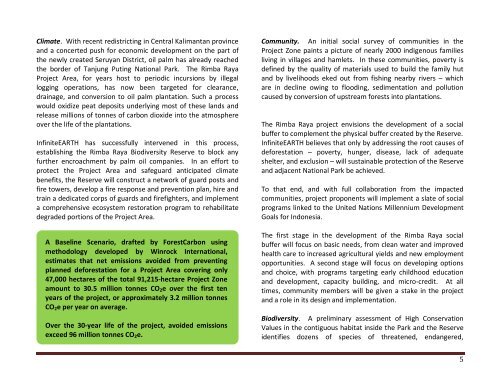The Rimba Raya Biodiversity Reserve REDD Project
The Rimba Raya Biodiversity Reserve REDD Project
The Rimba Raya Biodiversity Reserve REDD Project
Create successful ePaper yourself
Turn your PDF publications into a flip-book with our unique Google optimized e-Paper software.
Climate. With recent redistricting in Central Kalimantan provinceand a concerted push for economic development on the part ofthe newly created Seruyan District, oil palm has already reachedthe border of Tanjung Puting National Park. <strong>The</strong> <strong>Rimba</strong> <strong>Raya</strong><strong>Project</strong> Area, for years host to periodic incursions by illegallogging operations, has now been targeted for clearance,drainage, and conversion to oil palm plantation. Such a processwould oxidize peat deposits underlying most of these lands andrelease millions of tonnes of carbon dioxide into the atmosphereover the life of the plantations.InfiniteEARTH has successfully intervened in this process,establishing the <strong>Rimba</strong> <strong>Raya</strong> <strong>Biodiversity</strong> <strong>Reserve</strong> to block anyfurther encroachment by palm oil companies. In an effort toprotect the <strong>Project</strong> Area and safeguard anticipated climatebenefits, the <strong>Reserve</strong> will construct a network of guard posts andfire towers, develop a fire response and prevention plan, hire andtrain a dedicated corps of guards and firefighters, and implementa comprehensive ecosystem restoration program to rehabilitatedegraded portions of the <strong>Project</strong> Area.A Baseline Scenario, drafted by ForestCarbon usingmethodology developed by Winrock International,estimates that net emissions avoided from preventingplanned deforestation for a <strong>Project</strong> Area covering only47,000 hectares of the total 91,215-‐hectare <strong>Project</strong> Zoneamount to 30.5 million tonnes CO 2 e over the first tenyears of the project, or approximately 3.2 million tonnesCO 2 e per year on average.Over the 30-‐year life of the project, avoided emissionsexceed 96 million tonnes CO 2 e.Community. An initial social survey of communities in the<strong>Project</strong> Zone paints a picture of nearly 2000 indigenous familiesliving in villages and hamlets. In these communities, poverty isdefined by the quality of materials used to build the family hutand by livelihoods eked out from fishing nearby rivers – whichare in decline owing to flooding, sedimentation and pollutioncaused by conversion of upstream forests into plantations.<strong>The</strong> <strong>Rimba</strong> <strong>Raya</strong> project envisions the development of a socialbuffer to complement the physical buffer created by the <strong>Reserve</strong>.InfiniteEARTH believes that only by addressing the root causes ofdeforestation – poverty, hunger, disease, lack of adequateshelter, and exclusion – will sustainable protection of the <strong>Reserve</strong>and adjacent National Park be achieved.To that end, and with full collaboration from the impactedcommunities, project proponents will implement a slate of socialprograms linked to the United Nations Millennium DevelopmentGoals for Indonesia.<strong>The</strong> first stage in the development of the <strong>Rimba</strong> <strong>Raya</strong> socialbuffer will focus on basic needs, from clean water and improvedhealth care to increased agricultural yields and new employmentopportunities. A second stage will focus on developing optionsand choice, with programs targeting early childhood educationand development, capacity building, and micro-‐credit. At alltimes, community members will be given a stake in the projectand a role in its design and implementation.<strong>Biodiversity</strong>. A preliminary assessment of High ConservationValues in the contiguous habitat inside the Park and the <strong>Reserve</strong>identifies dozens of species of threatened, endangered,5
















